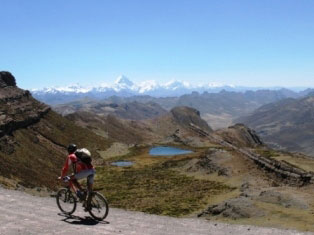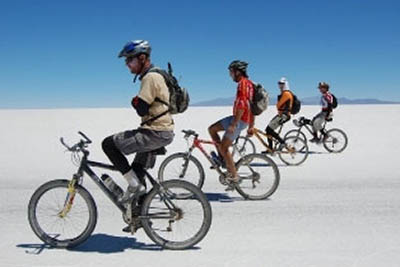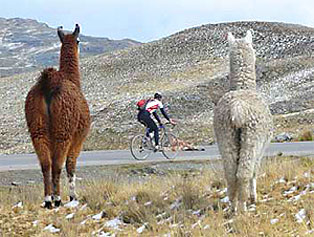Biking the Andes Trail Expedition
By Kaitlyn Silva

If ordinary bicycle tours aren’t enough to satisfy the intrepid traveler in you, it’s time to take a journey through the challenging but spectacular scenery of the Andes Trail in South America.
In 2008, twenty steadfast biking enthusiasts traveled 11,000 kilometers (or 6,875 miles) from Mitad-del-Mundo monument at the equator just outside Quito, Ecuador to Ushuaia, Argentina, known as “the end of the world.”
The expedition was put together by Bike Dreams, a long-distance cycling company based in the Netherlands.
The cyclists endured 107 different stages through high altitudes and rocky terrain from August to December for 2008, the time of year during which the weather was expected to be the least erratic.
On an average day, they biked four to six hours, though some particularly agonizing stretches of the trail took up to eleven hours to pedal through.
Bike Dreams’ Wilbert Bonné chronicled the journey in Cycle Diaries from The Andes Trail, a title that is based upon Che Guevara’s Motorcycle Diaries.
High Altitude Intensity
Before the journey’s halfway point, the cyclists spent the majority of their nights in hotels along the trail. In the deserted, high altitude section of trail in Peru, that option disappeared.

The travelers set up one of a series of campsites in the Peruvian mountains of the Andes, where the temperature swelters by day and falls below freezing by nightfall.
It is here that the cyclists reach the highest altitude of the entire trip. Slowly moving along the trail at heights varying from 4,600 to 4,900 meters, they gasp for air as if they were “breathing through a straw.”
Cycling past Mount Yerapaja, the second largest mountain in Peru, the group witnessed scenery not usually associated with South America: ice fields and glaciers appeared as frequently as lakes and herds of llamas in the region.
An abundance of vegetation, including approximately six-foot cacti and 10-foot sunflowers, lined the trail.

Forty kilometers on the small, gravely dirt trail took approximately three hours to cycle, slightly longer than the average trail. By the end of the day’s itinerary, which was created specifically to avoid the several popular animal crossings in the area, the bikers reached a small village.
“We wave to little kids and greet colorful dressed Indians with ‘Hola’. They welcome us – or not – with ‘Gringo, gringo’ which means something like ‘foreigner’ or ‘stranger’. Some kids start to cry and run to their parents when they see white people moving forward on blinking aluminum creations.”
The Cycle Diaries describe the quaint surroundings and stunning visuals along the way. “We pass narrow gorges, follow fast-floating rivers and the scenery is once more fabulous; it’s like the décor of a western movie. The setting sun between the mountains makes the panoramas even more striking.”

The Saltiest Place on Earth
Though many unfamiliar travelers would assume mountains to be the prominent geographical feature of the Andes Trail, Bolivia offered the cyclists another surprising landscape created by Mother Nature.
After looping around a volcano, the expedition team was soon speeding over Salar de Uyuni – the world’s largest salt flats. At 12,000 square kilometers, Salar de Uyuni is a roughly quarter of the size of Bike Dreams’ founding nation, the Netherlands.
Salar de Uyuni provided each cyclist with a wide-open space to pedal to his or her heart’s desire.
It was an unusual scene along a path none of the travelers have ever gone down before — an endless sea of sand, cut in hexagonal shapes as their trail.

With no animals, civilization, or even breezes along the plains, the only sound during the several-hour trip was the crackling of salt underneath the bicycle tires.
The only patch of land that the cyclists came across between their start point and end destination was Isle de los Pescadores, a tiny island mainly covered in cacti that grow up to six feet high, whose name ironically translates to “Isle of the Fisherman.”
The mountains in the distance slowly inched closer until the biking group reached Hotel Playa Blanca in the town of Uyuni. The hotel is a tribute to its special location with salt walls, salt furniture, and a salt museum.
Torture from the Patagonian Weather Gods

That was the rumor the Andes Trail cyclists were told throughout the first half of their travels. When they finally reached Patagonia, they realized that sentiment was the awful truth.
The bicyclists faced a devastating obstacle in the mountains of Argentina, where they had no choice but to walk their bikes against vicious winds after realizing that pedaling was just not possible. They staggered along the rocky trail under the sheer force of the wind tunnel, sand and gravel blowing up into their faces.
“The scenery is amazingly beautiful with its fresh green grass, monkey puzzle trees, rocks and melt water creeks, but the wind conditions make our ‘cycling’ day harsh.

“Nobody gives a damn about the scenery. The wind takes all our attention. The squalls rage with high speeds around our faces and ears.
No time for a normal conversation, even screaming doesn’t make sense… The wind blows through a funnel from the snow-covered Andes Mountains into the wide Patagonian Plains.
“I know nothing about Beaufort or wind forces, but I can tell you: hurricane levels and beyond… far, far beyond. It’s unbelievable. The situation becomes ominous, even dangerous.”
On a particularly challenging curve, everyone ended up in ditches on the side of the road. The bicycles fly up into the air as if they were lightweight sheets of paper with cyclists serving as their only anchor.
After the first cyclists make it to a pit stop, they send out their rescue team to collect the others who are still crawling in the ditches, moving at a pace of roughly 3 to 4 kilometers per hour.
Though they faced a major delay, they had passed by the treacherous wind tunnels caused by the mountainous landscapes and thus their travel troubles. Despite their exhaustion, the group soldiered on so they could stay on schedule.
The End of the World
After four months of cycling along a diverse and difficult route, the cyclists on the first Andes Trail race and expedition reached Ushuaia, Argentina, as planned on December 14, 2008.
Sean Solon of Ireland, triumphed over 106 of the 107 stages consecutively and thus won the racing challenge. He and the two other cyclists to first cross the finish line greeted the rest of the group wearing traditional South American ponchos.
The celebration began after the entire team made their way across the finish line with a nude dive into the freezing waters of the Antarctic, the last event in a series of astonishing adventures.
If you’re looking for a high intensity cycling adventure, Bike Dreams is organizing a second Andes Trail expedition that will run from August 6 to December 12 of 2010.

Kaitlyn Silva is a journalism major at the University of Massachusetts at Amherst and an editorial assistant at GoNOMAD.
- Greece Getaway: Camping Hacks for Your Next Getaway - April 25, 2024
- Products and Clothing You Might Enjoy - April 25, 2024
- Saudi Arabia Might Be Your Next Getaway Spot - April 23, 2024

